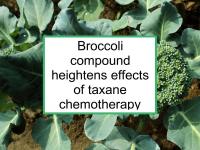Cruciferous vegetables contain a variety of sulfur compounds called glucosinolates that are converted into isothiocyanates with chemopreventive properties, including sulforaphane, phenethyl isothiocyanate, allyl isothiocyanate, 1-naphthyl isothiocyanate, phenethyl isothiocyanate, benzyl isothiocyanate and erucin.
High urinary isothiocyanate levels have been found to be related to lower breast cancer risk among both premenopausal and postmenopausal women. Now a new study has reported that sulforaphane potentiates the cytotoxic effects of taxane chemotherapy (paclitaxel or docetaxel) in triple negative (ER-/PR-/HER2-) breast cancer by reducing the breast cancer stem cell population.
Sulforaphane is an isothiocyanate that has been shown to reduce inflammation, inhibit both estrogen receptor positive (ER+) and estrogen receptor negative (ER-) breast cancer cell proliferation, and induce breast cancer cell apoptosis (programmed cell death). Sulforaphane acts to prevent the reduction of ER expression in human breast cancer cells. Sulforaphane has also been shown to reduce the growth of breast cancer stem cells and impair their viability. In addition, sulforaphane has been found to suppress primary tumor growth in a mouse model of breast cancer, as well as reducing axillary lymph node metastasis in mice.
Food sources of sulforaphane
Unlike some plant-based chemopreventive compounds, meaningful amounts of sulforaphane can be obtained from food. However, raw vegetables are best. In addition, lightly cooked fresh broccoli has been shown to be superior to lightly cooked frozen broccoli. Furthermore, raw broccoli sprouts or broccoli are far better sources of sulforaphane than cooked broccoli or freeze-dried broccoli pills. This is primarily because isothiocyanates are obtained from glucosinolates when the enzyme myrosinase is released from damaged plant cells.
Myrosinase is physically separate from glucosinolates in intact plant cells. Chewing or chopping a cruciferous vegetable enables the myrosinase to catalyze the reaction that converts its glucosinolates into isothiocyanates. This is part of the plant defense mechanism which is triggered when, for example, an animal chews the plant. This mechanism is disabled when such vegetables are cooked, although human intestinal bacteria facilitate some formation and absorption of isothiocyanates. In addition, glucosinolates are water soluble and can be leached into cooking water.
The following are the best dietary sources of sulforaphane:
- Broccoli sprouts (by far the best source)
- Broccoli
- Brussels sprouts
- Cabbage
- Bok choy or Chinese cabbage
- Kohlrabi
Latest research finds sulforaphane reduces stem cell population
The study referenced at the beginning of this news story was designed to investigate the effects of combining taxanes (paclitaxel or docetaxel) with sulforaphane on breast cancer stem cells in triple negative breast cancer. Cancer stem cells are thought to have nearly unlimited proliferative and self-renewal capabilities. The proportion of breast cancer stem cells typically increases in cell cultures as they develop resistance to chemotherapy. In the study, the authors demonstrated that paclitaxel or docetaxel treatment did, in fact, induce increases in the breast cancer stem cell population in triple negative breast cancer cell cultures. On the other hand, sulforaphane was found to be capable of preferentially eliminating breast cancer stem cells, dramatically reducing both the size and number of primary and secondary mammospheres formed.
The authors then conducted further studies using a mouse model of triple negative breast cancer (incorporating triple negative xenografts). Both primary tumor volume and secondary tumor formation were found to be reduced more significantly in mice treated with both docetaxel and sulforaphane than mice treated only with either docetaxel or sulforaphane. The authors conclude that treatment of triple negative breast with cytotoxic chemotherapy could benefit from the addition of sulforaphane to prevent expansion of the breast cancer stem cell population as well as eliminating established breast cancer stem cells.
Please see our articles on diet for paclitaxel and triple negative breast cancer for more information.
